Living Lawns: Your Healthy Lawn Care Resource

In the past fifteen years, there has been a dramatic increase in the use of pesticides and fertilizers by homeowners in Maine.
These trends in lawn care practices have been detrimental to water quality throughout Maine. Phosphorus in stormwater runoff causes algae blooms in freshwater lakes and ponds. Nitrogen has a similar effect in coastal waters, especially in shallow bays and coves where pollutants tend to become concentrated. Most pesticides are neurotoxins that are harmful to people and wildlife. Children are particularly vulnerable because they are still growing and their body size is small.
The Town of Falmouth is committed to safeguarding the health and welfare of the residents of Falmouth and to conserve and protect Falmouth’s environment, water, and natural resources by working with and providing resources to residents to ensure the proper use of outdoor pesticide and fertilizers in Falmouth.
Lawn Care Resources for Residents
If you hire a lawn care company, start by asking these seven questions. Then, consider these requests for your lawn care provider:
- Apply fertilizer in the early fall, based on soil test results, not on a fixed schedule. Applying fertilizer unnecessarily is a waste of time and money and pollutes our water.
- Use YardScaping practices to reduce pests instead of using weed and bug killers
- Set mower blades to 3″ and leave the clippings. Cutting grass high allows roots to develop, and leaving the clippings provides your lawn with a free source of fertilizer.
- Topdress by spreading a thin layer of compost over the lawn. Compost will add organic matter and increase soil depth.
- Overseed with a mixture of fescues and ryegrasses. Help out compete weeds and rejuvenate your lawn by adding new seed.
If you take care of your own lawn:
Growing a healthy, sustainable lawn doesn't have to be difficult. Follow these easy steps for a lush, green lawn that's safe for your family, your pets, and helps keep our waters clean:
Spring Greening: April-June. Mow high; let the clippings lie!
- If soil is very compact or low in loam, aerate and topdress with compost
- Seed bare spots with endophyte-enhanced perennial ryegrass
- Sharpen your mower blades, then mow grass at 2” to start, and increase to 3” for the rest of the season
- Always leave grass clippings on the lawn for free, natural fertilizer
- Take a soil test to have results for the fall - How to Test Your Soil
Strong For Summer: June-Early August. Water wisely!
- Water only when needed; lawns need 1-1.5” of water per week
- Apply compost tea to add nutrients and improve soil health (optional)
- Keep an eye out for yard pests and manage if needed
Grow and Store: August-October. Get the dirt on your dirt!
- After August 15 overseed with endophyte-enhanced a perennial ryegrass and fescue mix
- Take a soil test if you did not do one in the spring - How to Test Your Soil
- Follow soil test results for amending your soil
- Aerate and topdress with compost
- Mow to 2” for your final mow of the season
Plan and Prepare: October 15-April. Winter is coming!
- Avoid piling snow on the lawn (causes compaction)
- Sweep up sand and salt from driveways and walkways
- Plan for spring!
More lawn care resources:
- Living Lawns Flier
- Soil Management for Healthy Lawns and Environments PowerPoint (by Jason Lilley, Sustainable Ag. Professional with UMaine Cooperative Extension)
- The Importance of Soil, which includes information on HOW to test your soil!
- Grass Seed Mixes and When to Plant
- Managing Weeds
- Best Management Practices for Soil Erosion
- Ten Simple Steps Toward a Healthy and Safe Lawn
- Yardscaping Guide
- Some Sources for Organic Products
- Seven Questions to Ask Your Lawn Care Company
Below are also links to Presentations from past forums led by the Conservation Commission:
- "Audubon International" Presentation by J.B.. Christie with the Portland Country Club
- "Healthy Lawn Care for Falmouth" Presentation by Jami Fitch with Cumberland County Soil & Water Conservation District
- "Natural (Organic) Lawn & Turf Management, Based on a Systems Approach" Presentation by Chip Osborne with Osborne Organics
Living Lawns is an effort by the Falmouth Conservation Commission, in collaboration with theSustainability Office and the Cumberland County Soil and Water Conservation District.
| Attachment | Size |
|---|---|
| 350.68 KB |

